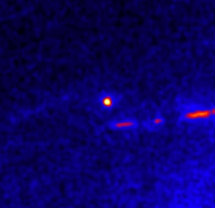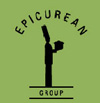

Thursday - February 19, 2009
SLAC Today is
available online at:
http://today.slac.stanford.edu
In this issue:
Key to Origin of the Universe Could Be in Neutrinos and Project X
A Gamma Source Close to Home
SLUO Goes to Washington
Reminder: "What's Hot, What's Not" at the Linear Café Today
 |
 |
|
Thursday - February 19, 2009 |
Key to Origin of the Universe Could Be in Neutrinos and Project XYou shouldn't be here. Not just reading this blog, but anywhere. You shouldn't exist. Period. Moments after the big bang, equal amounts of matter and antimatter floated through the universe and when particles of each collided, they annihilated each other, leaving nothing but free floating energy in their paths. Suddenly something changed, allowing for more matter than antimatter. The little extra bit that escaped annihilation clumped together and over time planets… and eventually you formed. But billions of years later no one knows exactly how that happened. "That's the puzzle," said Boris Kayser, a particle physics theorist with Fermi National Accelerator Laboratory. "You would have expected an empty universe. Funny. It is not empty. How did that happen?" Yet some scientists say they have the key in a new machine called Project X to unlock the mystery of the origin of the universe, and you. Last Friday, Kayser and fellow physicists Craig Dukes of the University of Virginia and Gregory Dubois-Felsmann of SLAC National Accelerator Laboratory told a crowd at the American Association for the Advancement of Science meeting in Chicago about the newest research front in particle physics—the intensity frontier—and the newest tool to reach it—Project X, a proposed proton accelerator. The talks focused on the study of rare decays, B factories, and the possible key to the universe: neutrinos. Read more in Symmetry Breaking... A Gamma Source Close to Home The FGST Large Area Telescope has spotted a gamma-ray source close enough to Earth to move
across the sky in just hours. (Image courtesy of NASA and Peter
Michelson.)
The Fermi Gamma-ray Space Telescope has recently reported discoveries of faraway stars pulsating in gamma radiation and erupting with gamma-ray blasts. Similar gamma flares have been powerful enough to ionize the Earth's upper atmosphere from 50,000 light years away. In a colloquium last week at the Canadian Institute of Theoretical Astrophysics, University of Toronto, FGST Large Area Telescope principal investigator Peter Michelson reported a gamma source close enough to Earth that it moved visibly across the telescope's field of view in just hours, against a still backdrop of stars. This gamma source, too, can ionize the Earth's upper atmosphere, and does so daily. It's the Sun. FGST is recording gamma emissions produced by high-energy cosmic rays colliding with the Sun's atmosphere. This glimpse of our local star is a testament to the new telescope's abilities. "The ability of the LAT to see very faint gamma-ray sources allows us to see the solar gamma-rays every day," Michelson said. FGST is the only gamma-ray observatory capable of detecting the sun at such high quality and monitoring it over the full 24 hour solar cycle, according to a recent LAT scientific poster. Read more about Michelson's talk in science journalist Ivan Semeniuk's blog. SLUO Goes to WashingtonMembers of the SLAC Users Organization are partnering with the Fermilab User's Executive Committee and U.S. LHC Users' Organization to prepare for the groups' annual, joint trip to Washington, DC. Representatives of each user group met at Fermilab in early February to begin planning the April 29–May 1 trip, when delegates will talk with representatives on Capitol Hill about physics in the U.S. "We try to take a message that's common to the users at the three organizations," said Steve Sekula, who co-chairs the SLUO subcommittee involved in the trip, along with co-chair Lisa Kaufman. "We come together, we set aside the lab-specific things, and we craft a common message about the importance of science to education, technology and basic knowledge." SLUO is seeking SLAC user input for this year's trip. Those interested can e-mail the organizers. Reminder: "What's Hot, What's Not" at the Linear Café Today Remember to drop by SLAC's Linear Café today between 4:00 and 5:00 p.m. for house-baked treats and espresso/tea drinks, and to provide input to the Epicurean Group, which provides the Linear Café's food services. Come let the staff know your thoughts about the café's service and food, and what they might do to make the Linear Café an even more inviting venue. All SLAC staff are invited; please RSVP to Linear Café General Manager Robin Martinez (x2615). |
Events
Access (see all)Announcements
|
|
| | ||
|
|
||
 <%
Response.AddHeader "Last-modified", getArticleDate()
'Response.AddHeader "Last-modified","Mon, 01 Sep 1997 01:03:33 GMT"
'Monday, December 06, 2010
%>
<%
Response.AddHeader "Last-modified", getArticleDate()
'Response.AddHeader "Last-modified","Mon, 01 Sep 1997 01:03:33 GMT"
'Monday, December 06, 2010
%>View online at http://today.slac.stanford.edu//. |
||